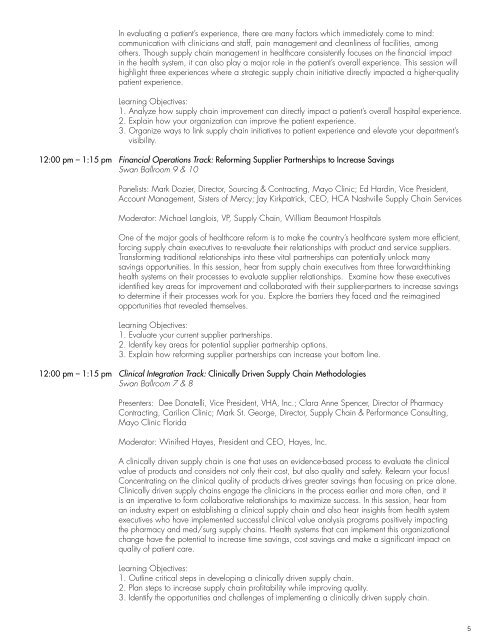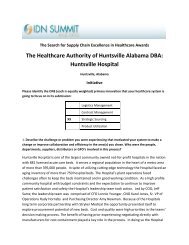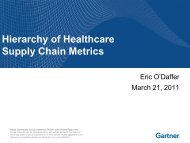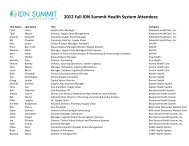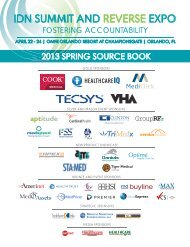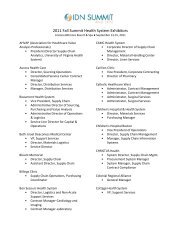PRE-SHOW GUIDE - IDN Summit and Expo
PRE-SHOW GUIDE - IDN Summit and Expo
PRE-SHOW GUIDE - IDN Summit and Expo
Create successful ePaper yourself
Turn your PDF publications into a flip-book with our unique Google optimized e-Paper software.
In evaluating a patient’s experience, there are many factors which immediately come to mind:<br />
communication with clinicians <strong>and</strong> staff, pain management <strong>and</strong> cleanliness of facilities, among<br />
others. Though supply chain management in healthcare consistently focuses on the financial impact<br />
in the health system, it can also play a major role in the patient’s overall experience. This session will<br />
highlight three experiences where a strategic supply chain initiative directly impacted a higher-quality<br />
patient experience.<br />
Learning Objectives:<br />
1. Analyze how supply chain improvement can directly impact a patient’s overall hospital experience.<br />
2. Explain how your organization can improve the patient experience.<br />
3. Organize ways to link supply chain initiatives to patient experience <strong>and</strong> elevate your department’s<br />
visibility.<br />
12:00 pm – 1:15 pm Financial Operations Track: Reforming Supplier Partnerships to Increase Savings<br />
Swan Ballroom 9 & 10<br />
Panelists: Mark Dozier, Director, Sourcing & Contracting, Mayo Clinic; Ed Hardin, Vice President,<br />
Account Management, Sisters of Mercy; Jay Kirkpatrick, CEO, HCA Nashville Supply Chain Services<br />
Moderator: Michael Langlois, VP, Supply Chain, William Beaumont Hospitals<br />
One of the major goals of healthcare reform is to make the country’s healthcare system more efficient,<br />
forcing supply chain executives to re-evaluate their relationships with product <strong>and</strong> service suppliers.<br />
Transforming traditional relationships into these vital partnerships can potentially unlock many<br />
savings opportunities. In this session, hear from supply chain executives from three forward-thinking<br />
health systems on their processes to evaluate supplier relationships. Examine how these executives<br />
identified key areas for improvement <strong>and</strong> collaborated with their supplier-partners to increase savings<br />
to determine if their processes work for you. Explore the barriers they faced <strong>and</strong> the reimagined<br />
opportunities that revealed themselves.<br />
Learning Objectives:<br />
1. Evaluate your current supplier partnerships.<br />
2. Identify key areas for potential supplier partnership options.<br />
3. Explain how reforming supplier partnerships can increase your bottom line.<br />
12:00 pm – 1:15 pm Clinical Integration Track: Clinically Driven Supply Chain Methodologies<br />
Swan Ballroom 7 & 8<br />
Presenters: Dee Donatelli, Vice President, VHA, Inc.; Clara Anne Spencer, Director of Pharmacy<br />
Contracting, Carilion Clinic; Mark St. George, Director, Supply Chain & Performance Consulting,<br />
Mayo Clinic Florida<br />
Moderator: Winifred Hayes, President <strong>and</strong> CEO, Hayes, Inc.<br />
A clinically driven supply chain is one that uses an evidence-based process to evaluate the clinical<br />
value of products <strong>and</strong> considers not only their cost, but also quality <strong>and</strong> safety. Relearn your focus!<br />
Concentrating on the clinical quality of products drives greater savings than focusing on price alone.<br />
Clinically driven supply chains engage the clinicians in the process earlier <strong>and</strong> more often, <strong>and</strong> it<br />
is an imperative to form collaborative relationships to maximize success. In this session, hear from<br />
an industry expert on establishing a clinical supply chain <strong>and</strong> also hear insights from health system<br />
executives who have implemented successful clinical value analysis programs positively impacting<br />
the pharmacy <strong>and</strong> med/surg supply chains. Health systems that can implement this organizational<br />
change have the potential to increase time savings, cost savings <strong>and</strong> make a significant impact on<br />
quality of patient care.<br />
Learning Objectives:<br />
1. Outline critical steps in developing a clinically driven supply chain.<br />
2. Plan steps to increase supply chain profitability while improving quality.<br />
3. Identify the opportunities <strong>and</strong> challenges of implementing a clinically driven supply chain.<br />
5


